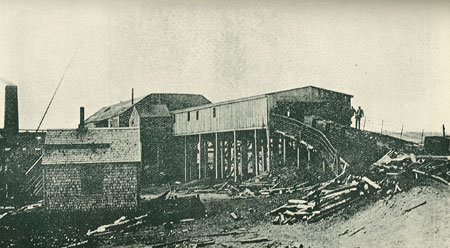We love getting questions about mining, minerals and geology! We were asked about mining in Victoria Mines, #CapeBreton.
We are going to discuss #VictoriaMines + #NewVictoria since their mining histories are closely linked.
#nspoli #cbpoli #novascotia @KCoombesMLA @JaimeBattiste

We are going to discuss #VictoriaMines + #NewVictoria since their mining histories are closely linked.
#nspoli #cbpoli #novascotia @KCoombesMLA @JaimeBattiste


The first land grants in #VictoriaMines were given to Irish settlers in 1794 and in New Victoria in 1808.
#Coal mining in the area began in 1865 with what we now call the Old Victoria Mine, which was likely the 1st mine in North America planned to be completely...
#nspoli #cbpoli
#Coal mining in the area began in 1865 with what we now call the Old Victoria Mine, which was likely the 1st mine in North America planned to be completely...
#nspoli #cbpoli

...under the sea floor. It was based on the shore just north of the intersection of the New Waterford Highway (#28) and Lake Road (circled in red on the map below). The #coal from this mine was conveyed by a railway 5.5 kms long to the Victoria Pier at South Bar for shipment. 

The mine’s two slopes were abandoned in 1870 due to water inflow problems and a new set of slopes were opened 250 metres to the northeast, again right along the shore – which was an unfortunate mistake to make once, never mind twice.
#nspoli #cbpoli #novascotia #capebreton
#nspoli #cbpoli #novascotia #capebreton

Being so close to the shore did not leave enough rock cover between the subsea tunnels and the ocean floor above. This allowed sea water to enter the mine through faults or other structural features of the geology.
#nspoli #cbpoli #novascotia #capebreton @KCoombesMLA
#nspoli #cbpoli #novascotia #capebreton @KCoombesMLA

The mine closed in 1878 after having more water issues and a boiler explosion killed three workers. It produced a total of 820,411 tons of coal.
#nspoli #cbpoli #novascotia #capebreton @KCoombesMLA @JaimeBattiste
#nspoli #cbpoli #novascotia #capebreton @KCoombesMLA @JaimeBattiste

The #NewVictoria Mine was opened by the General Mining Association in 1883 about two kms northeast of the Old Victoria Mine (circled in green). Both mines were called Victoria when they opened but they were subsequently referred to as “New” and “Old” to distinguish between them. 

The new mine caused both population and economic activity to shift from #VictoriaMines to the immediate area around the new mine. The Old Victoria Mine’s rail line was extended to the New Victoria Mine so it could also send its #coal to #SouthBar for shipping.
#nspoli #cbpoli
#nspoli #cbpoli

The #NewWaterford Highway is said to follow the path of the old rail bed.
The mine was sold to the Dominion #Coal Company in 1894 and closed in 1897 due to rock fall issues. It was dewatered in 1913 and reopened in 1914 under a new name: Dominion No. 17 Colliery.
#nspoli #cbpoli
The mine was sold to the Dominion #Coal Company in 1894 and closed in 1897 due to rock fall issues. It was dewatered in 1913 and reopened in 1914 under a new name: Dominion No. 17 Colliery.
#nspoli #cbpoli

However, it closed that same year, reportedly due to a lack of miners during WWI.
In 1918, No. 17 Colliery was pumped out and kept open until 1921, when it closed again on July 15. The colliery had produced an estimated 5,183,000 tons of #coal.
#nspoli #cbpoli #novascotia
In 1918, No. 17 Colliery was pumped out and kept open until 1921, when it closed again on July 15. The colliery had produced an estimated 5,183,000 tons of #coal.
#nspoli #cbpoli #novascotia

A new mine, Dominion No. 18, opened in New Victoria in 1938 about 1.5 kms to the east of the No. 17 on Daley Road (circled in purple). No. 18 worked the Phalen #coal seam until 1946, producing 1,531,320 tons.
#nspoli #cbpoli #novascotia #capebreton @KCoombesMLA @JaimeBattiste
#nspoli #cbpoli #novascotia #capebreton @KCoombesMLA @JaimeBattiste

In 1946 a tunnel was driven from No. 18’s working into the Harbour Seam, which lies over the Phalen Seam in that area.
#nspoli #cbpoli #novascotia #capebreton @KCoombesMLA @JaimeBattiste
#nspoli #cbpoli #novascotia #capebreton @KCoombesMLA @JaimeBattiste

In 1948 the No. 17 Colliery workings were pumped out and production in No. 17 started again in Feb. 1950. No. 17 and 18 tunnels were now linked underground and coal from No. 17 was removed via No. 18’s slopes. Production continued until 1966 when both 17 and 18 closed.
#nspoli
#nspoli

In 1962 an airway was completed due West of Lamey’s Lane in #NewVictoria to service the eastern portion of the Princess Colliery whose main shafts were approximately 6 kilometres to the west, the other side of #Sydney Harbour, at Cranberry Head in #SydneyMines.
#nspoli #cbpoli
#nspoli #cbpoli

The site was abandoned when the Princess mine closed in 1975.
#VictoriaMines and #NewVictoria are part of what was originally called Low Point by early settlers - the entire point from Sydney Harbour to #Lingan.
#nspoli #cbpoli #novascotia #capebreton @KCoombesMLA @JaimeBattiste
#VictoriaMines and #NewVictoria are part of what was originally called Low Point by early settlers - the entire point from Sydney Harbour to #Lingan.
#nspoli #cbpoli #novascotia #capebreton @KCoombesMLA @JaimeBattiste

The increase in #coal exports after the General Mining Association got a monopoly on mineral rights in Nova Scotia in 1826 made it important to mark the entrance to #Sydney harbour to keep ships safe.
#nspoli #cbpoli #novascotia #capebreton @KCoombesMLA @JaimeBattiste
#nspoli #cbpoli #novascotia #capebreton @KCoombesMLA @JaimeBattiste

The first Low Point Lighthouse, in #NewVictoria at the mouth of #Sydney harbour, was built in 1832. It was wooden with a lead roof. The wooden tower was replaced in 1938 with the concrete tower that stands at the site today.
#nspoli #cbpoli #novascotia #capebreton @KCoombesMLA
#nspoli #cbpoli #novascotia #capebreton @KCoombesMLA

• • •
Missing some Tweet in this thread? You can try to
force a refresh



























